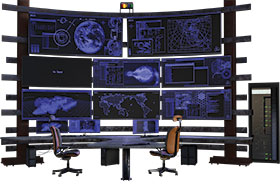

Facility managers and building owners are looking to obtain greater control and create greater efficiency in their buildings. In South Africa, large organisations are just beginning to realise the advantages that open building automation systems (BAS) can offer. The benefits are enormous but there are also challenges.

So, what exactly is an open BAS and how does openness drive benefits?
In the world of building systems and technology, openness refers to the use of standard data formats and communications protocols in the design, delivery and use of building automation systems. Tapping into the power of openness – through standard and open protocols, procurement, APIs and software tools – makes it easier to ensure compatibility across different systems and networks, maintain systems efficiently, and expand capabilities as technologies evolve.
Open BAS, for example, offer the ability integrate traditional building systems with business and vertical market specialty systems, directing and scheduling system interactions to deliver desired outcomes. They can help create better business outcomes, such as reduced energy spend or consumption; increased operational efficiencies; reduced IT security risk; and the ability to better maintain safe, comfortable and productive environments.
Open systems are not all roses though. By its very nature, an open architecture presents a number of challenges. It can be difficult to maintain consistency, eliminate version complexities and ensure system security within an open system. Organisations will thus need to approach open BAS with their eyes wide open.
Optimising the benefits of openness
Within a building automation system (BAS), openness is typically associated with one or more of the following characteristics: open protocols, open procurement, open APIs and open software, tools and support. There are advantages and disadvantages to each.
Open protocols to support BAS integrations
Protocols are sets of rules that govern the exchange of data over a computer network. In the HVAC industry, the development of open or standard protocols is led by a number of professional societies and member organisations. Common examples include BACnet/IP, TLS and OPC. The key is that they are not owned or maintained by a commercial entity - they are in the public domain.
Open protocols help BAS owners get more from their investments by creating a common language between systems and data, making it easier and more cost effective to integrate and expand, and broadening the pool of people with the knowledge and experience to maintain the systems efficiently.
The downside is this: Standard protocols are updated frequently. Keeping them in sync and managing different versions can be challenging – especially when multiple vendors are involved. As you consider open protocols for a BAS selection or upgrade, it’s helpful to define what you need, now and in future:
• Does the BAS use standard, open protocols that can easily support upgrades or expansion? Are the protocols up to date?
• Do you know what you need it to accomplish both today and in the future?
• Have you documented goals such as improving maintenance practices or monitoring electrical, water or energy usage?
This will help ensure that the BAS you choose will give you the flexibility to connect to controllers, devices and systems you’ll need in the future.
Open procurement to build a BAS from multiple suppliers
Open procurement refers to the ability to purchase a product or products from multiple suppliers, a strategy often used by those who are concerned about being locked into a single vendor. There are definite advantages to making use of open procurement:
• It can create competitive pressures among suppliers and help keep costs down.
• It can help with sourcing when controllers or replacement controls are available from multiple sources.
• It can expand the talent pool, making a broader range of people available to develop, deliver, manage and maintain building automation systems.
Open procurement does have disadvantages, however. When working with multiple vendors, it can be difficult to hold individual suppliers accountable for issues, or maintain consistency during upgrades and expansion. Open procurement can also lead to multiple systems from multiple providers residing in a single building, each with its own tools for management and maintenance. And with the layered complexity of a BAS including sensors, equipment and servers, operators may have vastly different experiences with different components, making training and troubleshooting more difficult.
As you consider leveraging open procurement, start by doing your homework on potential vendors.
• Is their product proven in environments and applications similar to yours?
• Do the company’s service providers have the training, knowledge and experience to consistently deliver throughout the warranty period and without hidden costs?
• Clearly documented roles and responsibilities can ensure that there are no overlaps or gaps.
Open APIs for BAS customisation
When a building automation system supports an open Application Programming Interface (API) that means it gives third-party developers the ability to create custom tools and applications based on data generated by the BAS. The use of APIs can be an effective way to integrate building system data with other software applications or tools and can shorten the time needed to develop customised applications. But APIs can be risky.
• By inviting third parties to access BAS data, the system will be inherently less secure and more vulnerable to threats and hackers.
• Withdrawing an API can be painful for users of systems that need to be consolidated or retired, as they’ll lose their data.
• Software that uses APIs heavily can be impacted by changes on either the BAS or application side, which can disrupt operations.
As you consider using open APIs for your building automation system, start by assessing whether your current BAS is capable of meeting the need so you won’t have to assume the risk associated with opening your network to third-party developers. If you do choose to leverage open APIs, you can minimise the risk by involve your company’s IT team to ensure protection against vulnerabilities, and by putting a plan in place for supporting and training people who will use the third-party applications.
Open software tools and support for BAS updates
Open software tools and support refers to the practice of extending access to the BAS beyond the original vendor, so that others (either the BAS user or other vendors) can reconfigure the BAS or connect it to other new or upgraded systems. Having open access to software and tools gives BAS users more service options, including self-service.
The disadvantage is this: When a number of different individuals are allowed to make changes to a BAS, inconsistencies can be introduced.
As you consider granting open access to software tools and support, start by making sure the original BAS contractor provides, installs and sets up all the software tools necessary for a trained person to configure and program the building automation system. Next, assess whether your organisation has experienced, trained technicians who can add to or make changes to the BAS. If not, it may be more cost effective to consider external vendors.
Either way, establish guidelines for who will be allowed to make changes to the system. Document the level of experience you’ll require and develop standards within which the vendors (or your own employees) must work. And keep in mind, as new projects are taken on, it will be important to determine and document who provides the tools and who owns the software licences.
For more information contact Johnson Controls, +27 (0)11 921 7141, [email protected], www.johnsoncontrols.com
© Technews Publishing (Pty) Ltd. | All Rights Reserved.